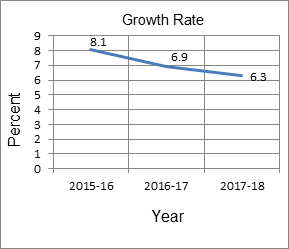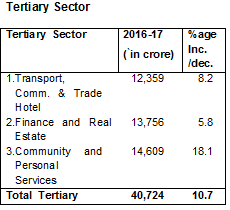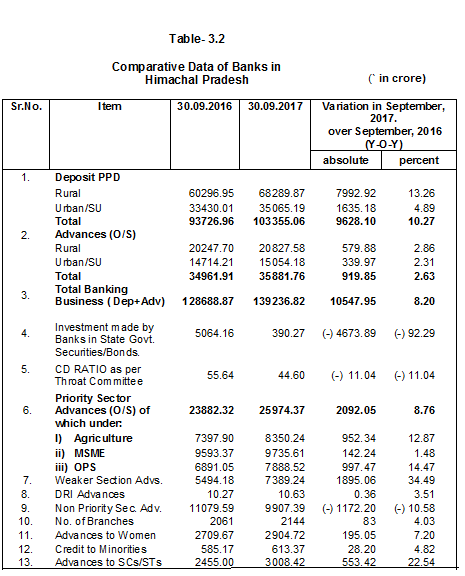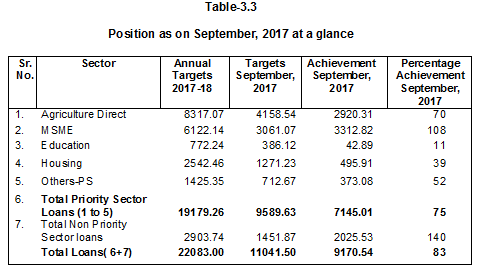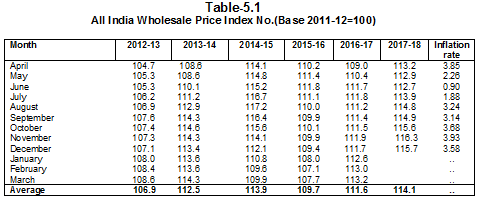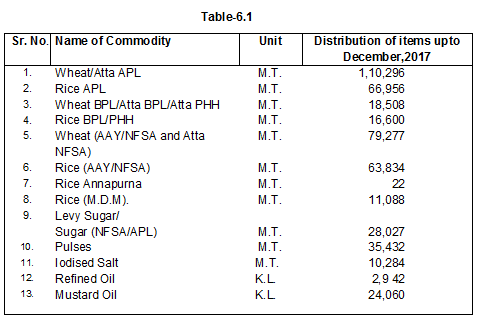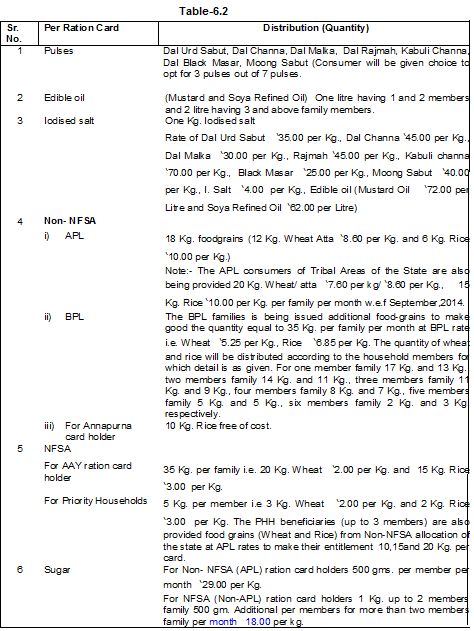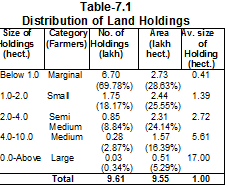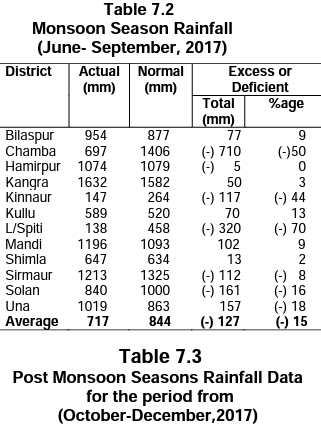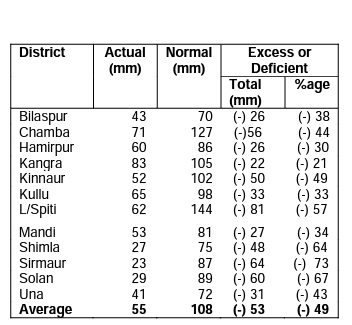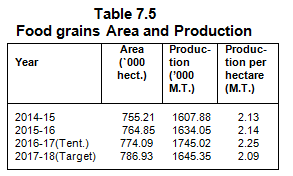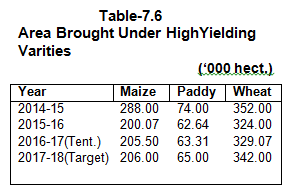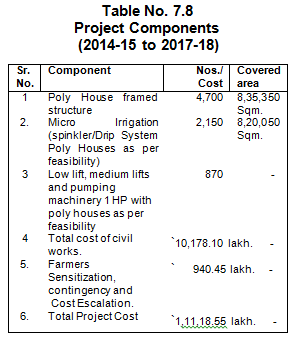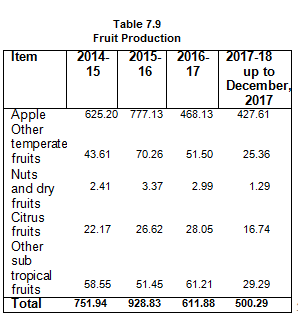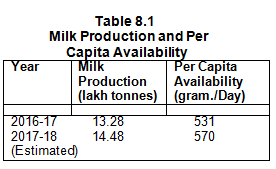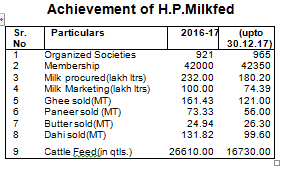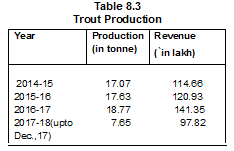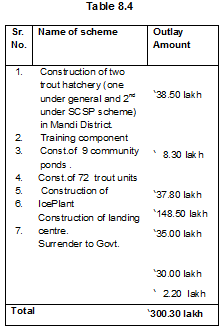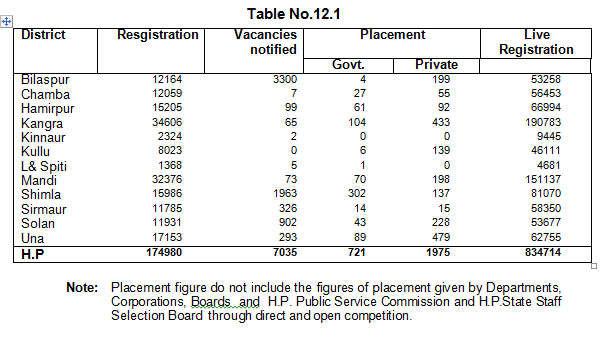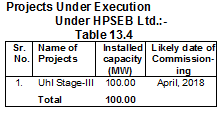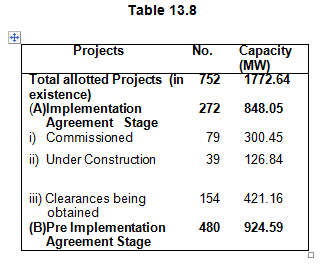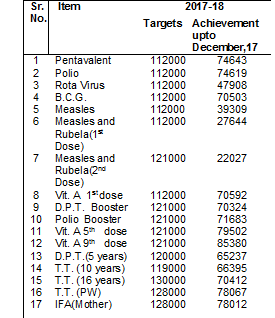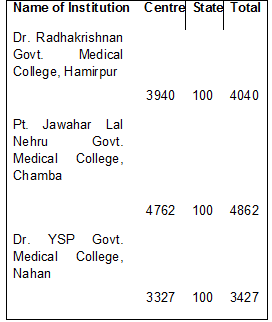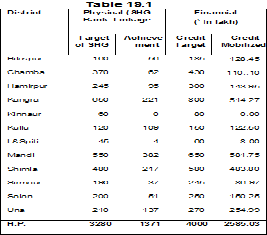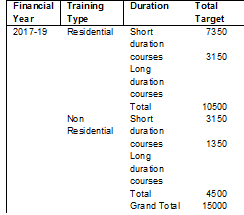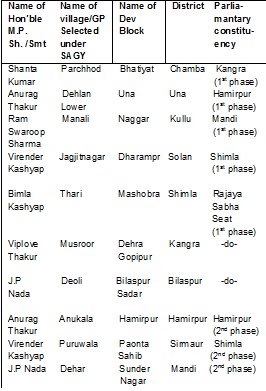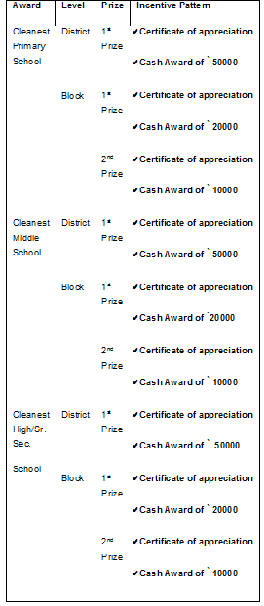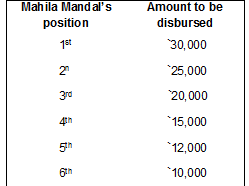The State Gross Domestic Product (GSDP) at factor cost at current prices, is estimated at `1, 24,236 crore in 2016-17 as against `1,13,355 crore in 2015-16 showing an increase of
9.6 percent during the year. At constant (2011-12) prices in 2016-17 is estimated at `1,02,954 crore as against `96,274 crore in 2015-16 registering a growth of 6.9 percent during
the year as against the growth rate of 8.1 percent during the previous year. The increase in total State Domestic Product is mainly attributed to 18.1 percent in community &
personal services sectors, 8.2 percent increase in transport and trade, 7.1 percent in manufacturing sector, 5.8 percent in finance & real estate,
5.4 percent in construction and 2.9 percent increase in electricity, gas & water supply. Whereas the Primary sector has shown a marginal decrease
of 0.7 percent. Food-grains production, which was 16.34 lakh MT during 2015-16 has increased to 17.45 lakh MT during 2016-17 and is targeted at
16.45 lakh MT in 2017-18. The fruit production has
decreased by 34.1 percent i.e from 9.29 lakh MT in 2015-16 to 6.12 lakh MT in 2016-17 and during 2017-18 (up to December, 2017) production was 5.00 lakh MT.
The per capita income at current prices witnessed an increase of 9.1 percent as it increased to `1,46,294 in 2016-17 from `1,34,089 in 2015-16.
As per the advanced estimates and on the basis of economic conditions up to December, 2017, the likely growth rate for 2017-18 will be around 6.3 percent.
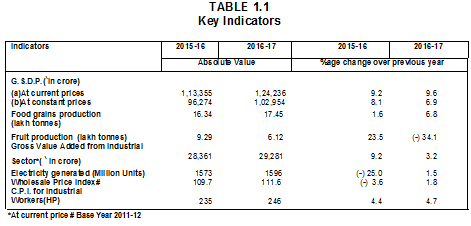
The economic growth in the State is predominantly governed by agriculture and its allied activities showed not much fluctuations during nineties as the growth rate remained more or less stable. The economy has shown a shift from agriculture sector to industries and services as the percentage contribution of agriculture and allied sectors in total State Domestic Product has declined from 57.9 percent in 1950-51 to 55.5 percent in 1967-68, 26.5 percent in 1990-91 and to 9.7 percent in 2016-17. 1.13 The share of industries and services sectors respectively has increased from 1.1 & 5.9 percent in 1950-51 to 5.6 and 12.4 percent in 1967-68, 9.4 & 19.8 percent in 1990-91 and to 25.2 and 44.0 percent in 2016-17. However, the contribution of other remaining sectors showed a favourable shift i.e. from 35.1 percent in 1950-51 to 30.8 percent in 2016-17. 1.14 The declining share of agriculture sector do not, however, affect the importance of this sector in the state economy as the state economic growth still is being determined by the trend in agriculture and horticulture production. It is the major contributor to the total domestic product and has overall impact on other sectors via input linkages, employment and trade etc. Due to lack of irrigation facilities our agricultural production to a large extent still depends on timely rainfall and weather conditions. High priority has been accorded to this sector by the Government. 1.15 The State has made significant progress in the development of horticulture. The topographical variations and altitudinal differences coupled with fertile, deep and well drained soils favour the cultivation of temperate to sub-tropical fruits. The region is also suitable for cultivation of ancillary horticultural produce like flowers, mushroom, honey and hops. 1.16 During the year 2017-18 up to December, 2017, 5.00 lakh tonnes of fruits were produced in the state and
it is envisaged to bring 3,000 hectares of additional area under fruit plants against which 2,552 hectares of area has already been brought under plantation and 6.69 lakh fruit
plants of different species were distributed up to December, 2017.
Growing of off-season vegetables has also picked up in the state. During the year 2016-17, 16.54 lakh tonnes
of vegetables were produced as against 16.09 lakh tonnes in 2015-16 recorded a growth rate of 2.8 percent. It is anticipated that the production of vegetables will be of the order of 15.40 lakh tonnes in 2017-18.
Himachal Pradesh continued to take ambitious steps to achieve its targets. In the area of climate change mitigation. The State action plans on climate change
aim to create institutional capacities and implement sectoral activities to address climate change.
In view of the growing need of the State economy, the government has embarked upon a programme to provide uninterrupted continuous access
to power supply in the state. Several steps have been taken for increasing power generation, strengthening of transmission and distribution. As a source
of energy, hydro power is economically viable, non-polluting and is environmentally sustainable. In order to restructure the sector, the Power Policy of the
State attempts to address all aspects like capacity addition energy security, access and availability, affordability, efficiency, environment and assured
employment to people of Himachal.
Though the private sector participation in terms of investments in this sector has been encouraging but the smaller projects
has been reserved for investors from Himachal Pradesh only (up to 2 MW) and preference will be given for projects up to 5 MW.
Tourism is a major engine of economic growth, an important source of revenue earnings and a generator of employment of diverse kinds. The State Govt. has also developed appropriate infrastructure for its development which includes provision of public utility services, roads, communication network, airports, transport facilities, water supply and civic amenities etc. As a result of high profile media thrust, a significant rise has been noticed in the domestic as well as foreign tourist inflow during last few years as below:-
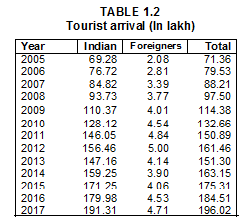
Information Technology has a great scope for employment generation and revenue earnings. The HIMSWAN provides various G2G, G2C, G2B,
e-Procurement and e-Samadhan etc. systems to bring efficiency and transparency in administration.
The annual plan for 2018-19 has been proposed at `6,300.00 crore which will be 10.5 percent higher than the plan size of current year 2017-18.
Containment of prices is on the priority list of Government. Himachal Pradesh Working Class Consumer Price Index number during 2017-18
increased by 5.3 percent in December, 2017 as against 4.0 percent at National level .
The priority of the government has always been for social welfare programmes. Concerted efforts have been made to improve
the efficiency and quality of public services delivery. Some of the major achievements taken during the year are:-
1) All persons above the age of 70 years will be provided an old age pension irrespective of any income limit except those drawing any other pension.
2) All the departments have been directed to prepare targets to be achieved by their departments within the next 100 days for unique and innovative activities.
3) Additional Interim Relief of 8 percent of the basic pay has been provided to Government employees and pensioners with effect from 1.01.2016.
4) Under Smart City Mission Municipal Corporation Shimla has also been approved by Government of India.
5) Under “Public Service Guarantee Act 183 services in
25 departments has been implemented for efficient and timely solutions.
6) Social security Pension increased from `650 to `700 per month.
7) Under the skill development scheme an allowance of `116 crore has been distributed to 1,58,100 beneficiaries.
8) Out of the total farmers only 43 percent of the farmers have been issued Kisan Credit Cards by the banks.
9) Essential commodities are being supplied on subsidized rates to 18,38,036 ration card holders in the State so as to save them from the on- slaught of rising prices.
11) To save and promote agriculture activities from the menace of stray animals, wild animals and monkeys the government has enhanced subsidy to 80 percent under the Mukhyamantri Khet Sarkasan Yojna .
12) Under Restructured weather Based Crop Insurance Scheme(R-WBCIS) total of 2,86,378 number of farmers have been covered till Kharif and Rabi crop in 2016-17 season.
13) To bring diversification in horticulture industry an area of 156.19 hectares has been brought under flower cultivation upto December, 2017.
14) The R-WBCIS is being implemented in 36 blocks for apple, 41 blocks for Mango, 15 blocks for Citrus, 13 blocks for Plum and 5 blocks for Peach crops.
15) During the financial year 2016-17, 1,596 million units of electricity were generated.
16) 10,519 MW hydro power has been harnessed out of 27,436 MW identified potential which comes out to 38.34 percent.
17) Under Mahatama Gandhi National Rural Employment Guarantee scheme 156.54 lakh man days have been generated by providing employment to 4,32,005 households.
18) Under Rajiv Awaas Yojana 846 houses are being constructed in the State during current financial year.
19) Swachh Bharat Mission is being implemented in all the 12 districts of the State in project mode and Himachal is considered as a leading State in the field of Sanitation.
20) Under Matri Shakti Bima Yojna all women in the age group of 10-75 years, living below poverty line are covered in case of their death or disability.
21) Under National Rural Livelihood Mission a total of 3,280 women SHGs are proposed for assistance.
22) Under Saansad Adrash Gram Yojana in two phases 10 Panchayats have been adopted by the MPs.
23) 1,416 kms roads/paths/streets and drain are being maintained by 54 Urban Local Bodies.
24) Under Lal Bahadur Shastri Kamgar Avam Shahari Ajivika Yojna, an amount of `1.50 crore has been provided for wage employment in newly created/merged areas of Municipal Councils/Corporations in the Pradesh.
25) 160 beneficiaries were provided skill training under National Urban Livelihood Mission and 33 persons have been provided placement.
26) Special attention is being given to quality education and to achieve the target of universalization of elementary education under Sarva Shiksha Abhiyan is vigoursly implemented
27) A programme named PRAYAS PLUS has been started in all upper primary schools for the popularisation and innovation in Science and Math.
28) Free education is being provided to girl students in the State upto University level.
29) The girl students studying in classes IX to XII belonging to SC, ST, OBC, minority communities and BPL families
are being provided with hostel facilities in the educationally backward blocks.
30) Under Post Matric Scholarship to SC/ ST/ OBC a total of 45,351 students have been benefitted.
31) To improve the quality education two Govt. Senior Secondary Schools have been designated as Aadrash Model Schools in each constituency of each district.
32) To improve the educational status of the deprived section of the society, various types of scholarships/ stipend are being provided by the State/ Central government at various stages.
33) Medical University has to set up in District Mandi.
34) Under National Rural Health Mission 95 Health Institutions are identified to provide 24 hours emergency services.
35) 1.05 lakh smart cards have been issued under Mukhya Mantri State Health Care Scheme to the selected families .
36) Under “BETI HAI ANMOL Yojna” 16,908 girls have been benefitted.
37) Under Mukhya Mantri Kanyadaan Yojna 691 beneficiaries were covered upto December, 2017 .
38) During the current year 219 couples have been benefitted under inter caste marriage and grant has been increased from `25,000 to `50,000.
39) Under Mata Shabri Mahila Sashaktikaran Yojna `1,300 are being provided to eligible women for the purchase of gas connection and total of 5,100 women have been benefitted.
40) To provide financial assistance and support services to Rape victims an amount of `75,000 is being provided.
41) Under Pradhan Mantri Matru vandana Yojna(PMMVY), a cash incentive of `5,000/- is being provided directly in the account of Pregnant
women and Lactating Mothers for first living child.
42) 16,521 childern have been benefitted under Mother Teressa Asahay Matri Sambal Yojana in the current financial year.
43) In order to ensure accountability, transparency, efficiency and to improve service delivery mechanism to general public web services has
been started for all planning & special areas in the State.
44) Himachal is the only State which has provided horizontal connectivity to 2,260 government offices in the State.
45) 2,308 Lok Mitra Kendras are active and providing 28 G2C services.
46) 52 e-services under e-district launched in all 12 districts.
47) Under Aadhaar scheme UID has been generated for more than 75.73 lakh (105 %) residents against the projected population of 2017.
48) The Per Capita Income has touched the level of `1,46,294 in 2016-17 witnessing a growth of 9.1 percent over 201516 and is estimated at `1,58,462 in 2017-18.



